Original article by David Graper, former SDSU Extension Horticulture Specialist and Master Gardener Program Coordinator. Updated by Kristine Lang, Assistant Professor and SDSU Extension Consumer Horticulture Specialist.
Spring and fall are both excellent times to re-evaluate your current gardens and identify spots to incorporate new plants. Do you have any large areas of bare soil in the garden, or perhaps a location that is difficult to mow? Consider planting perennial ground covers to fill in extra space in your sunny location!
About Ground Covers
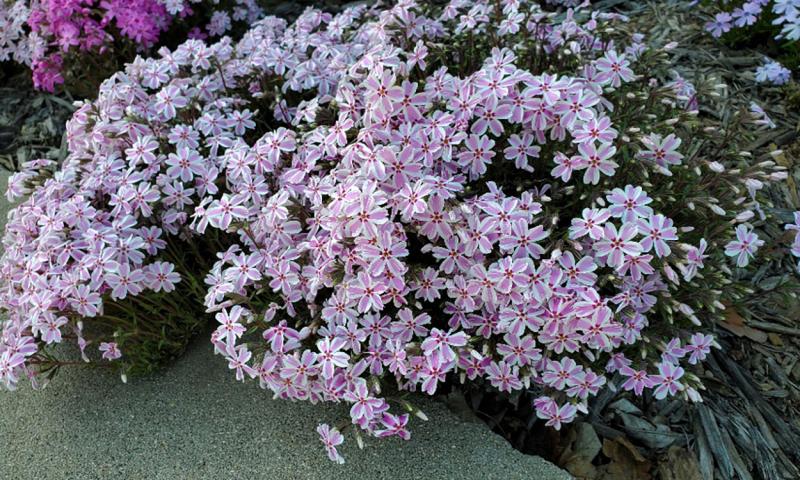
Sunny flower gardens are often filled splashes of brightly colored perennial flowers that may grow several feet tall. However, ground covers, which are usually twelve inches tall or shorter, are an important component of any landscape and are more common than you might think.
Ground cover plants generally serve the following purposes:
- Cover the soil to protect it from erosion by wind or water.
- Shade the soil to reduce the likelihood of undesirable plants to become established.
- Shade the soil to keep it cooler and reduce water loss from it.
- Occupy the soil itself with roots to compete with potentially invasive plants.
- Add beauty and interest to a landscape.
Most ground cover plants will spread out over or in the soil, producing new plants as they grow. Rhizomes are underground stems utilized by some plants, like lily of the valley, while stolons, spreading above ground stems, are produced by other plants, like bugle weed. Grasses and other monocotyledonous plants may also produce rhizomes, stolons, offsets or tillers to expand the territory that they cover. These are all great characteristics for a ground cover to have, particularly in challenging locations, like a hillside, that is prone to erosion and needs stabilization. However, that same propensity to spread can also make many of these plants aggressive competitors with other desirable plants that might also be in the landscape. So, choose your ground cover plants carefully so that you do not end up with a mass planting that is on its way to take over your garden a few years after planting.
Selections for Sunny Gardens
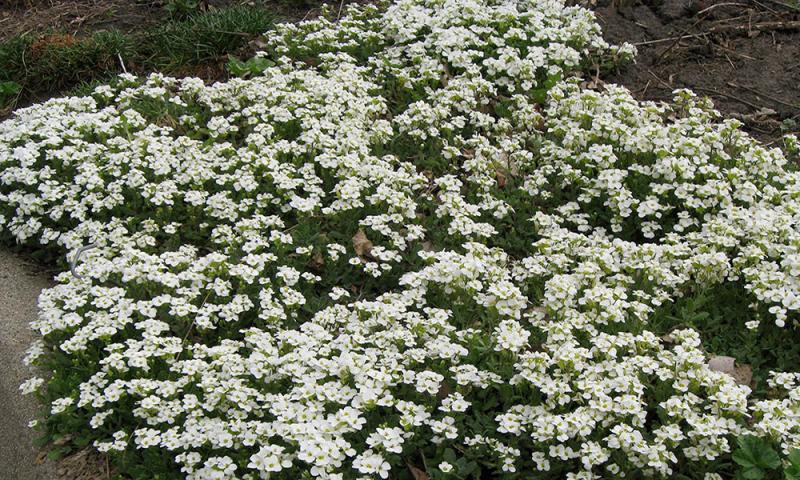
Mountain Rock-Cress
Mountain Rock-Cress (Arabis caucasica) is a heat and drought-tolerant plant, making it a good choice for a rock garden, where it will receive full sun to part shade and have well-drained soils to grow in. This is an attractive perennial ground cover, as it produces masses of white, four-petaled flowers in May on plants that grow only about three-to-six inches tall. Mountain Rock-Cress creeps along the ground, forming roots as it grows, so it can cover an ever-increasing area of a garden bed.
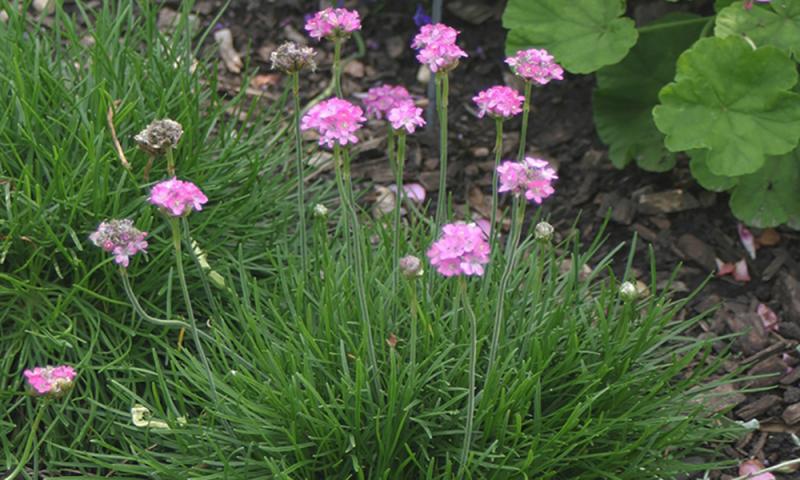
Common Thrift
Common Thrift (Armeria maritima) is a charming, small, clump-forming plant with grass-like leaves and rounded flower heads that come in bright pink or white. The primary flowering time is early summer, but plants may rebloom off and on all summer and into the fall, especially with proper deadheading. When in bloom, plants typically grow about six-to-eight inches tall. They will perform best in full sun to part shade. Since they have this clump-forming growth habit, it is best to plant them in groups or five or more. They can be used as an edging plant as well.
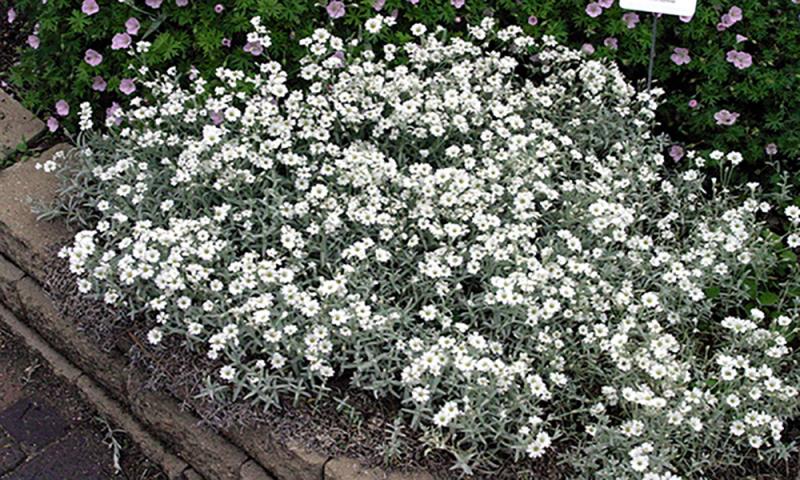
Snow-in-Summer
Snow-in-Summer (Cerastium tomentosum) is a low-growing, wooly-leaved plant that prefers a sunny location and to grow in a well-drained soil, but it can tolerate clay soil as long as it does not stay too wet for too long. Since it is drought and heat-tolerant, it works well with other xeric plants that need little water. It has small, white flowers in early to mid-summer that look great against its silvery foliage.
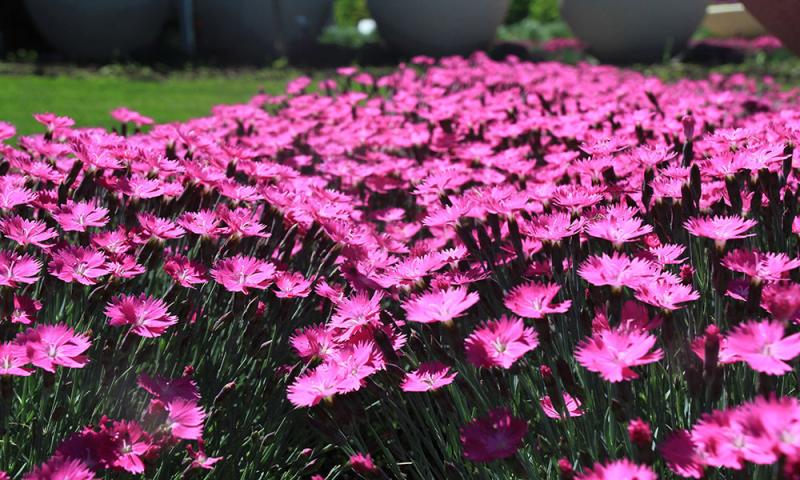
Cheddar Pink
Cheddar Pink (Dianthus gratianopolitanus) is a lovely, finely textured type of pink or carnation. It forms a matt of small plants with opposite leaves that are only about one-quarter inch wide and one and one-half inch long. In early summer, the flower stems grow to about six to 12 inches tall. Flowers have a nice, spicy scent as well. Flower color may range from white to vibrant pink, as is the case with 2006 Perennial of the Year, ‘Firewitch.’ Deadheading of this perennial encourages return blooms over the course of the summer and into the fall. Cheddar pinks grow best in full sun with well-drained soils. They are prone to rotting in overly wet locations.
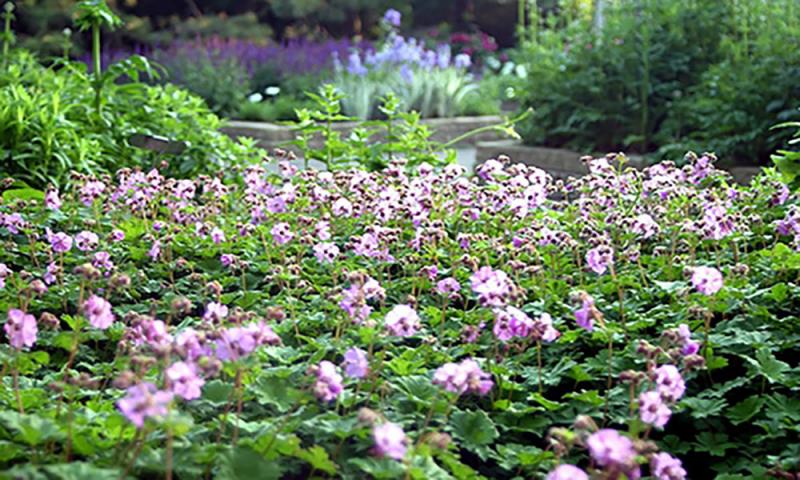
Bigroot Geranium
Bigroot Geranium (Geranium macrorrhizum) is just one example of the different hardy geraniums that can be grown in South Dakota gardens. While many gardeners are familiar with the common annual geraniums sold as bedding plants (which are species in the genus Pelargonium), hardy geraniums work well in many locations and can provide a nice floral display and attractive foliage, as well as fall color in some cases. One of the best spreaders, and therefore a good ground cover, is the Bigroot Geranium. It has leaves similar to annual geraniums with their general rounded shape and slightly scalloped edge, but it stays relatively short, only about eight to 15 inches tall. In early summer, many flower stalks develop, usually in shades of white, pink or lavender. Each flower stalk will usually only have about six to eight flowers, appearing more airy than annual geraniums.
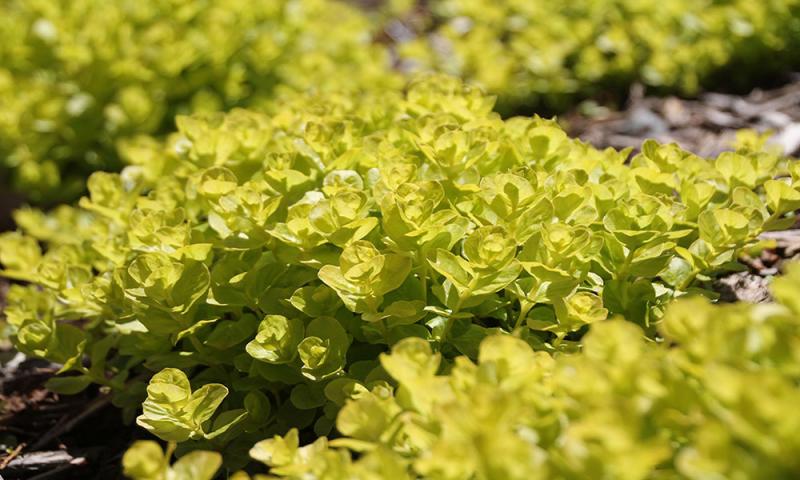
Moneywort
Moneywort (Lysimachia nummularia) is an aggressive ground cover that only grows about two-to-four inches tall when in bloom. It has small, round, three-quarter inch opposite leaves that form along its thin, prostrate stems. This plant will form a dense mat of foliage that will block out most weeds. It looks great creeping over the edge of a wall or rocks, and it puts on quite a show when the small, bright yellow flowers appear in summer in profusion. The most-sold cultivar, ‘Aurea,’ also has golden-yellow foliage. This plant will grow well in full to part sun.
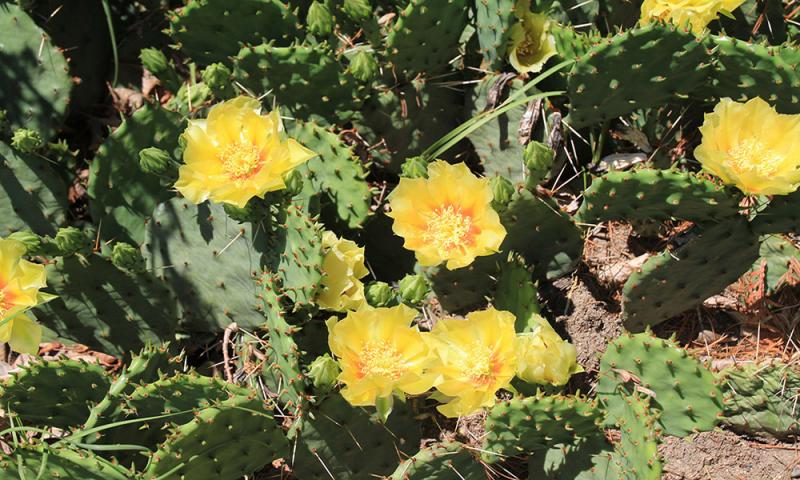
Prickly-Pear
Prickly-Pear (Opuntia macrorhiza) is a tough plant for tough sites, particularly hot, sunny locations with poor soils that are rocky or gravely or even high in clay. This plant will not tolerate wet locations. Many gardeners might avoid prickly-pear cactus because of the sharp spines; however, the flowers are very attractive and might make it worth adding this plant to your low-input garden. Typically, the flowers are yellow to peach in color, but new hybrids are becoming available with flowers that range in color from white to lavender, pink and red. You’ll want to be intentional about where you plant this ground cover, so it does not become a weed in your yard – this is certainly not a plant that you would want to step on while barefoot.
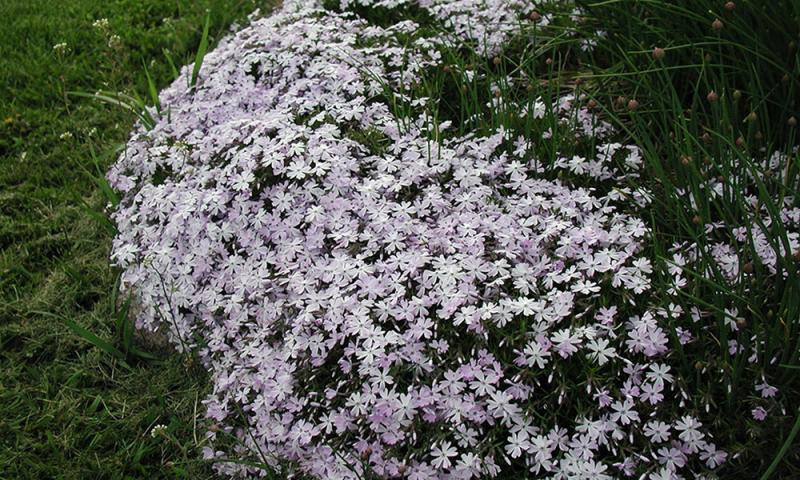
Moss Phlox
Moss Phlox (Phlox subulata) has short, needle-like, nearly evergreen foliage on fine, somewhat wiry stems. It will form a mat of foliage 12 to 24 inches wide and later flowers that will grow three-to-six inches tall, giving the plant an overall mossy-appearance. It grows best in part to full-sun location. Its flowers range in color from white, to pink, red-purple and violet-purple, and they appear in early spring. The flowers attract butterflies. Moss phlox are drought tolerant, performing best in well-drained soils. The texture of this plant’s foliage also aids in deterring deer.
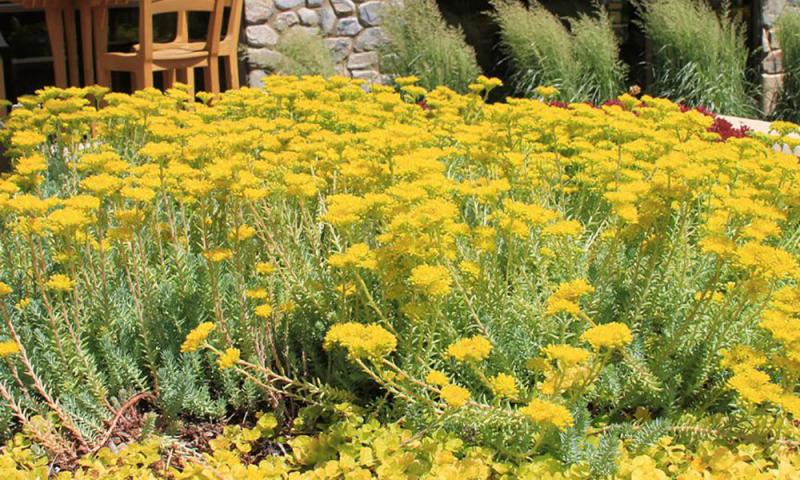
Stonecrop
Stonecrop (Sedum sp.) is one of the most-varied types of ground cover plants you can find at the garden center. Various species will grow from only a few inches tall to over two feet tall. Foliage can range in size from tiny, needle-like scales to large, succulent leaves several inches long and over an inch wide. Their common name of stonecrop is well-deserved in that they often grow their best in sandy, rocky, well-drained soils and will often have a better chance of surviving a cold winter if they are in a dry location. Most species and cultivars have an impressive floral display during mid to late-summer of small, star-shaped flowers that may range in color from white to yellow, pink, lavender, pink, red or purple. Foliage may range in color from plain green to chartreuse or burgundy to nearly black. They all grow best in full sun, but they can take some shade.
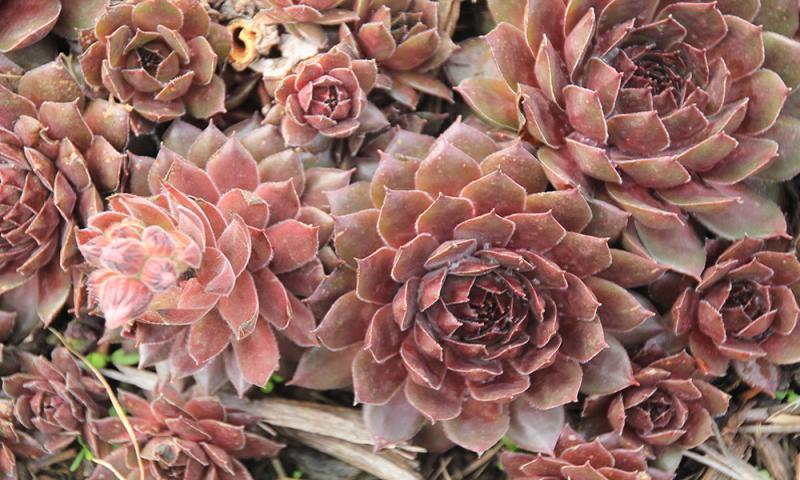
Hens and Chicks
Hens and Chicks (Sempervivum sp.) are an interesting group of succulent plants with an attractive rosette-type growth habit. The foliage is generally evergreen but may show some wilting over the winter. They are known as Hen and Chicks because in the spring they will send out small runners from the base of the plant that will sprout new baby plants, often referred to as the chicks. There are several different types and dozens of different cultivars ranging in foliage color and size. The arachnoidium species have what looks like webbing between the individual leaves. Sempervivums are monocarpic, meaning that when an individual plant matures, it sends up a flower stalk, sets seed and dies. The flower stalk may will tower one-to-three feet over the plant foliage. This European native was commonly planted on the thatched roofs of homes, where it was thought to bring good luck and also to help hold the thatch and, later, roof tiles together. Now it is mostly used in rock gardens or in containers. It has great drought tolerance and grows best in full sun.
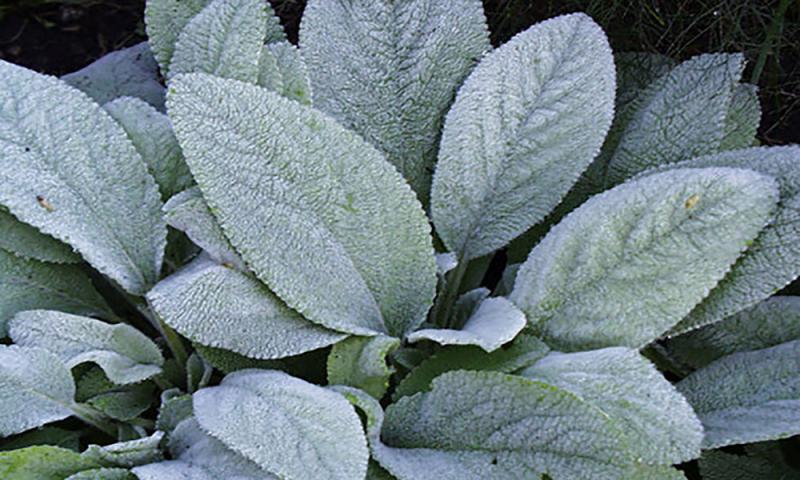
Lamb’s Ears
Lamb’s Ears (Stachys byzantina) have soft, furry leaves that give this hardy perennial its common name. Like other fuzzy-leaved plants, it is best planted in a sunny location. Avoid spots that will receive frequent sprinkler irrigation or shade, as this will encourage rotting of the leaves. This member of the Mint family produces flower stalks about 15 to 20 inches tall in mid-summer that bear lavender-pink flowers in the axils of the small leaves along the flower spike. Some people will just cut off the flower spikes when they develop to help reduce the chances of the plant spreading by seed and because some gardeners find that the flower spikes detract from the appearance of the plant.
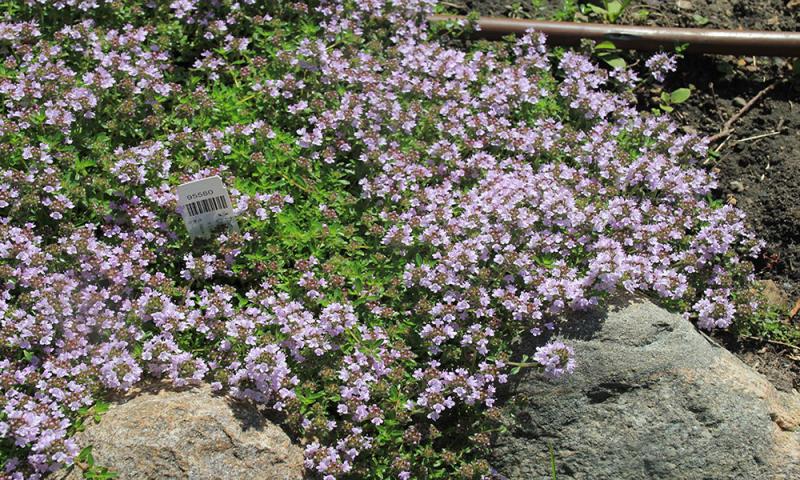
Wild Thyme
Wild Thyme (Thymus serphyllum) is a multi-purpose plant that makes an excellent and aggressive ground cover that will outcompete most weeds. The plant will be covered in delicate, lavender flowers that attract bees and other pollinators, and the foliage has a nice fragrance when crushed. Wild Thyme is often planted along walkways, where the fragrant foliage may be brushed or stepped on while walking to emit the fragrance. The stems and flowers may also be used as a flavoring for cooking or teas. Wild Thyme grows best in full sun to part shade and flowers mid-summer.

Common Periwinkle
Common Periwinkle (Vinca minor) is a low-growing, twining, perennial plant with glossy, evergreen foliage. The smooth stems will often root down as they creep along the ground, making it an effective ground cover, particularly for stabilizing slopes. It produces tubular, lavender flowers in late spring and again intermittently over the course of the rest of the summer. It grows in average soils and performs best in full sun to part shade, but it can also tolerate full shade.
Purchasing Perennial Ground Covers
This list did not cover all the plants that make excellent sun-loving perennial ground covers, so be sure to visit your local garden center for additional options. When selecting perennial ground covers, remember to check that the plant’s hardiness zone matches the conditions where you live. While not all interesting plants may be hardy enough to survive South Dakota winters, there are still many hardy plants to choose from. For additional gardening ideas, visit a botanical garden, such as McCrory Gardens, to get ideas for perennial ground covers for filling in your sunny garden.
References and Resources
- Armitage, A. 2020. Herbaceous Perennial Plants: A Treatise on their Identification, Culture, and Garden Attributes. (4th Ed.) Stipes Publishing. Champaign, IL, USA.
- North Carolina State Extension. North Carolina Extension Gardener Plant Toolbox.


